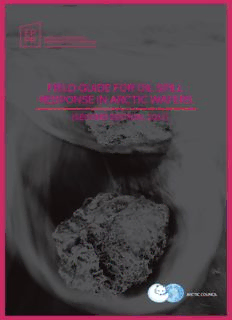
field guide for oil spill response in arctic waters PDF
Preview field guide for oil spill response in arctic waters
FIELD GUIDE FOR OIL SPILL RESPONSE IN ARCTIC WATERS (SECOND EDITION, 2017) ISBN 978-82-93600-29-9 (digital, PDF) © Arctic Council Secretariat, 2017 This report is licensed under the Creative Commons Attribu- tion-NonCommercial 4.0 International License. To view a copy of the license visit http://creativecommons.org/licenses/y-nc/4.0 Suggested citation EPPR, 2017, Field Guide for Oil Spill Response in Arctic Waters (Second Edition, 2017). 443 pp. The revised second edition was funded by the Oil Spill Recovery Institute, Prince William Sound Science Center in Cordova, Alaska, as a project of EPPR. Authors E.H. Owens, Owens Coastal Consultants L.B. Solsberg, Counterspil Research Inc. D.F. Dickins, DF Dickins Associates, LLC This EPPR project was led by the United States, with contribu- tions for Arctic States, Permanent Participants, and Arctic Council Working Groups. Published by Arctic Council Secretariat This report is available as an electronic document from the Arctic Council’s open access repository: https://oaarchive.arctic-council. org/handle/11374/2100 Cover image © Xxsalguodxx – stock.adobe.com Inside cover painting “Arctic” by Christopher Walker Field Guide for Oil Spill Response in Arctic Waters (Second Edition, 2017) DISCLAIMER Nothing in the Guide shall be understood as prejudicing the legal position that any Arctic country may have regarding the determi- nation of its maritime boundaries or the legal status of any waters. Regardless of suggested response strategies and procedures shown in this Guide, it is expected that individual Nation's will fol- low their respective national response system protocols. Legend Bullets safety concerns with respect to human life and health operational considerations that might limit or enhance a strategy or technique strategies or techniques recommended for a given scenario, usually appropriate strategies or techniques not recommended for a given scenario, rarely appropriate Seasons Environments open water (water is free of seas any ice forms) freeze-up lakes (new ice is forming) breakup rivers (mature ice is melting) frozen (ice is solid, usually shorelines continuous) Oil Locations oil on the surface in oil beneath ice open water oil submerged under oil on ice open water oil on water surface oil submerged under mixed in ice solid ice oil submerged under broken ice Oil Viscosity Ranges medium light (like heavy (like water) (like tar) molasses) ABOUT EPPR The Arctic Council was established in 1996 as a high-level forum to provide a means for promoting cooperation, coordination, and interaction among the Arctic States, with the involvement of the Arctic indigenous communities and other Arctic inhabitants. The Council focuses its work on matters related to sustainable development, the environment, and scientific cooperation through six standing Working Groups with input from expert groups and ad-hoc task forces. Emergency Prevention, Preparedness, and Response (EPPR) Working Group, one of the six standing working groups, is mandated to contribute to the prevention, preparedness and response to environmental and other emergencies, accidents, and Search and Rescue (SAR). While not an operational response organization, members of the Working Group conduct projects to address gaps, prepare strategies, share information, collect data, and collaborate with relevant partners on capabilities and research needs that exist in the Arctic. Projects and activities include development of guidance and risk assessment methodologies, coordination of response exercises and training, and exchange of information on best practices with regards to the prevention, preparedness and response to accidents and threats from unintentional releases of pollutants and radionuclides, and to consequences of natural disasters. EPPR strives to be the premier international forum for collaboration on prevention, preparedness and response issues in order to advance risk mitigation and improve response capacity and capabilities in the Arctic. CONTENTS About EPPR Lexicon 1 - 1 Introduction 2 - 1 Part A Operations First Responder’s Guide 3 - 1 Shoreline Response Strategies 4 - 1 Response Methods 5 - 1 Part B Technical Support Information Spill Behaviour and Tracking 6 - 1 Notification and Spill Response Decision Process 7 - 1 Human Health and Safety in the Arctic 8 - 1 Wildlife Response in the Arctic 9 - 11 Coastal Character of the Arctic Regions 10 - 1 References and Bibliography 11 - 1
Description: